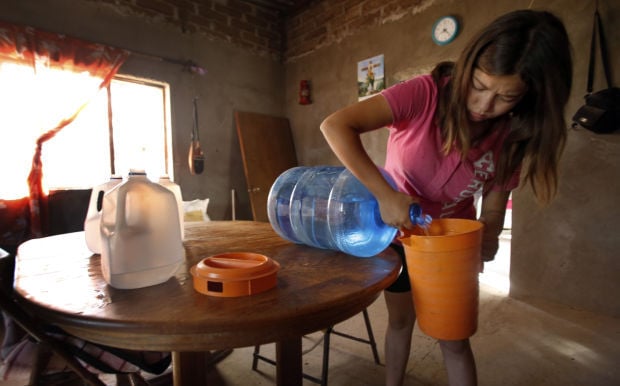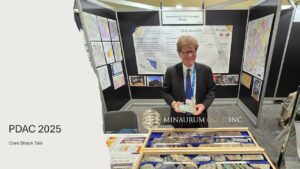
Photos by Kelly Presnell / Arizona Daily Star
In Banamichi, Sonora, Ana Maria Díaz wrestles a 5-gallon jug of water while redistributing the home’s supply of drinking water into gallon jugs. For days after the spill, many residents continued to drink water from contaminated wells.
ABOUT GRUPO MEXICO
Grupo Mexico is the largest mining company in Mexico and one of the top copper producers in the world. Through its subsidiaries it operates 13 mines in Mexico, Peru and the United States.
The company owns Tucson-based Asarco LLC, which operates the Silver Bell mine near Marana, the Mission mine near Sahuarita, the Ray mine near Kearny and a smelter in Hayden.
Although its mines also generate zinc, gold, silver and molybdenum, copper is king. In 2013, Grupo Mexico mines produced almost 800,000 tons of copper and the company reported a net profit of $1.8 billion off $9.3 billion in total sales.
Grupo Mexico gained control of the Buenavista del Cobre mine, then called the Cananea Copper Mine, in 1990, through a deal from the government of Mexican president Carlos Salinas de Gortari.
Before the Buenavista spill, the company's largest mining disaster occurred in 2006 at the Pasta de Conchos mine in Coahuila, where 65 miners lost their lives after an explosion. The mine operators were accused of lax safety standards and while there was a settlement paid to the families, no guilt was admitted.
Grupo Mexico has also had its share of labor disputes, including a series of strikes at the Cananea mine that culminated in a 2007 walkout over safety conditions. The union members of Sección 65 were eventually replaced, with a new union taking over in 2011. As a result of the strike, the company refuses to hire locals to work at the mine.
In 2008, the AFL-CIO came out against Grupo Mexico in its bid to regain control of ASARCO as it emerged from bankruptcy. The federation of unions said labor relations were marked by constant strife when Asarco was controlled by Grupo Mexico from 1999 to 2005.
Due to the current spill, the company has been threatened with not only sanctions and fines but the loss of the concession to operate the Buenavista mine.
Although the stock price for Grupo Mexico on the Mexican exchange fell after the spill, business analysts consulted by Reuters and Bloomberg do not seem concerned over possible fallout and continue to consider the company’s stock a good buy.
Source: Grupo Mexico's website, newspaper archives
BANÁMICHI, Sonora — Everything here comes from the river.
The water rushes along both sides of the lush green mountains teaming with ocotillo, mesquite trees, and even some organ pipe cactus. It is life to the towns in the Sonora valley.
Lydia Díaz had a good life here. The river provided her family’s cows with water to drink and grass to eat, offering her four teenage children their fill of milk every day — a whole liter at a time if they wanted that much.
She didn’t need to buy groceries — with the river’s help, the corn, beans, squash and green beans the family planted in a nearby field grew plentiful enough to feed all six of them.
She and her husband had jobs. Díaz cleaned the town’s swimming pool and her husband, Adolfo Escalante, worked the fields for the Lopez brothers, a local family that plants peanuts and runs a cattle business.
But all of that is gone.
•••
Between Aug. 6 and 7, about 11 million gallons of copper sulfate acid solution spilled from Cananea’s Buenavista del Cobre mine into the Bacanuchi River, a tributary of the Sonora River. The San Pedro River runs north from Cananea, about 25 miles from the Arizona border, while the Sonora River flows south. The spill contaminated the Bacanuchi and Sonora rivers and left more than 25,000 people in seven counties without water.
Mexican officials called it their country’s worst mining spill in recent history. And then it got worse. More than a month after the spill, heavy rains from Hurricane Odile caused the dams to overflow and the river to swell, soaking nearby fields with toxic water.
The crops are ruined and the people don’t know if they’ll be able to grow on their land again.
Residents don’t know much about the spill because reliable information has been hard to come by. They’re still not clear about how it happened, the full extent of the contamination or what the company and the Mexican government could have done to prevent it.
Díaz didn’t hear about the discharge for several days, and then only through word of mouth. Until then, her family had continued to bathe and drink from the contaminated wells.
The state newspapers are writing about the spill and its aftermath, but she said she rarely has the 10 pesos, less than $1, to buy one.
A neighbor from the nearby town of Arizpe learned the water was contaminated when he took his horse to drink from the river, which runs right by his property, and saw it running orange and red.
Since then, he said, a pregnant donkey miscarried and several puppies have died.
•••
Grupo Mexico, whose Cananea mine is one of the largest copper operations in the world, is not talking to the media about the spill. But it has said employees noticed a copper solution dripping from a containment dam at about 10 a.m. on Aug. 6.
Initially, the company said heavy rains led to the discharge, but later acknowledged it was due to faulty pipe seals in the Tinajas 1 system, part of the construction site of a new copper processing plant.
It took them 25 hours after the initial discovery to notify authorities — and two hours beyond that to contain the spill. The company built a barrier to stop the discharge and used lime to neutralize the acidity.
Adding lime “causes metal contaminants to precipitate out of solution which helps to contain the contamination in the area where it happened,” said Raina Maier, a professor in the University of Arizona’s Department of Soil, Water and Environmental Science. Its effectiveness depends on response speed, though, and questions linger about how long the containment dam had been leaking.
The solution that spilled was highly acidic and contained heavy metals such as arsenic, aluminum, copper, iron and manganese. While the acid can be neutralized, Maier said, the metals can either remain where they precipitate out of solution or they can move if they are not removed.
Grupo Mexico has contracted with several companies whose crews are removing contaminated silt with shovels and wheelbarrows. The company has said it’s about three-quarters done with the first phase of cleanup efforts.
•••
All wells within 1,600 feet of the river are closed.
Díaz and her neighbors rely on water jugs and the tanker trucks that fill the town’s communal water storage.
She has running water a few hours at a time, once or twice a day. It depends on how much the households closer to the water source have used before it gets to her.
“We used to be able to open the tap and drink from there,” she said. “The water was fresh.”
Not anymore. She realized how anxious she’s become when she was afraid to drink from the faucet at her mother’s home in Carbó, about three hours away.
The federal and state government continues to test the well water for acidity and heavy metals to determine when it’s safe and will open up new wells.
But the feeling of uncertainty and distrust is hard to shake. Residents and local officials even dispute the amount of acid that spilled.
“They say so many things that you don’t even know what to believe anymore,” said David López, who co-owns the business Díaz’s husband used to work for.
Díaz doesn’t know who to trust.
“We are still in the dark,” she said. “We don’t know what might happen to us now or how it may affect us in the future.”
Less than two-dozen cases of severe intoxication, from people who came into direct contact with the polluted water, have been reported.
There’s no telling how many others are suffering in silence. Díaz’s daughter-in-law developed rashes on her arms, thighs and breasts but is too embarrassed to go to the doctor.
Other people talk about having black feet after walking through the contaminated water.
“And if we get sick,” Díaz asked, “what are we going to do?”
Heavy metals can cause cancer, said Antonio Romo Paz, a chemist and biologist at the Universidad Sonora, during a recent forum about the spill.
“Heavy metals accumulate in the body and deposit in the bones and other organs, that’s why they are cancerous,” he said.
Díaz’s daughter, Lydia del Socorro, a petite 15-year-old, was born prematurely and has asthma and sensitive skin. She is bathing with purified water just in case, but her mother worries the contaminants of the spill will harm the fragile girl — and all her children.
•••
Grupo Mexico, which created a $150 million trust to clean up the spill and help residents, has distributed millions of liters of water throughout the communities along the river. It also opened a mobile water treatment plant in Huepác that produces 3,500 to 4,000 five-gallon jugs of purified water a day.
Dozens of tanker trucks fill the towns’ central water tanks or drive street by street filling plastic barrels people leave on the sidewalk in front of their house.
Some residents have invested several hundred dollars on a cistern-and-pumping system to have tap water for a few hours a day. The government is also starting to distribute some systems for free or at a reduced cost.
The cisterns, in black or beige, now dot the streets of towns like Banámichi.
Díaz couldn’t afford one, but her son works at a hardware store and was able to borrow one that was defective. Still, she tries to conserve as much water as possible in case she runs out.
She tries to keep a cistern full. Her husband fetches water from a nearby clean well to fill water jugs for washing and to flush the toilet.
She reuses the dishwater from the previous day, then rinses the dishes with water from the tanker trucks. But she doesn’t trust that the water is safe, so she gives the dishes a final quick rinse in the family’s ration of purified water.
Many people don’t trust the five-gallon water jugs emblazoned with the Grupo Mexico logo. Some claim to have found insects or mold inside them.
•••
As devastating as the spill has been for the river counties, with populations that range from a few hundred to nearly 10,000 people, this isn’t the first time it has happened.
Banámichi residents remember a spill in the mid-1980s, but little information is available about what happened and how it compares to the Aug. 7 discharge. López remembers seeing the sand a whitish color as a 10-year-old, but he doesn’t know what was in it.
In 1979, a major spill contaminated the San Pedro River. Earthen dams failed after harsh winter rains in 1977-78 and 1978-79 and polluted acids were released into the water, killing aquatic life over a 60-mile stretch north of the border, a 1987 Arizona State University report said. Water samples had high concentrations of heavy metals and high acidity.
Investigators believe minor spills had been occurring for years before the larger failures of the late 70s, the report said.
Both the San Pedro and the Sonora rivers are contaminated in their source areas from leaching of tailings, infiltrations of acidic leach solution, said Dick Kamp, an investigator for a 2003 report about mining-related water quality threats in Cananea and the watersheds.
Through the years and in the hands of different owners, the mine has had maintenance issues, including cracks on slopes and erosion.
On Sept. 20 of this year, Carlos Arias, head of the Sonora civil protection unit, issued a binational alert reporting that a small overflow of a retention pond had caused some discoloration on a tributary of the San Pedro River.
Acid and metal levels are within normal range, Arizona Department of Environmental Quality lab test results showed.
Cananea, where the mine is located, is the epicenter of the problem, said Sergio Maurin, a city councilman and former mineworker who is now part of a nonprofit called Súmate a Cananea. The group seeks solutions for the city, including job opportunities.
Maurin’s main concern is a tailing pond much larger than the pond that spilled in August.
“If that tailing pond fails,” he said, “it will destroy the whole state, not only the Rio Sonora.”
He is working to get the city included among the list of affected counties.
•••
Unlike in previous incidents, technology has helped document and expose the current spill damage.
When asked about what they saw, many residents pull out their smartphones and display photos of orange-red water or floating dead fish.
The mayor of Arizpe, Vidal Vázquez, even took a selfie at the site of the spill after September rains dumped more contamination into the river and posted it on Twitter. Media outlets immediately picked it up.
Before the spill, people here didn’t think contamination in Cananea affected them, said Adolfo López, the former mayor of Banámichi.
They saw the mine as something positive because it created jobs. Only “when people saw the river contaminated, they realized the magnitude of the problem,” he said.
Not only did the spill contaminate the Rio Sonora, López said, it destroyed its brand. Before, people associated the region with its beef, cheese, bread and pristine waters. Now, he said, the Sonora River equals contamination.
A Banámichi resident had to sell his 40 cows after dumping thousands of liters of milk down the drain because the government said it couldn’t be consumed. He didn’t have enough water for the cows to drink or to grow their food.
For the López brothers, not being able to water their peanut crop can mean a 50 percent loss if it doesn’t rain. Last year at this time, each plant had 80 to 90 peanuts. This year each has about 30.
The López brothers buy about 2,000 calves a year to export to the United States. They are struggling to find water the animals need to survive.
Their alfalfa field, which runs along the river, got soaked in contaminated water after the heavy rains brought by Hurricane Odile caused an overflow and it is now destroyed. They don’t know if the land will be usable again.
Inside a warehouse they have eight tons of barley seeds ready to sell — but no one to sell it to because people don’t want to risk not having enough water to irrigate. Normally, they would get about a $1,000 per ton.
October is also the time to plant garlic. But if they can’t use the wells, they won’t be able to plant this year.
“Our worst fear is that this land will be useless,” Adolfo López said.
Like most families in the region, theirs has been made up of farmers and ranchers for generations, each building on what came before.
“It’s sad to think you won’t be able to consume or sell what you grow,” said David López.
They’ve been working in the fields and with cattle since they were five or six years old.
David pulls out his phone and shows a picture of a toddler holding a hoe twice his size.
“That’s my son,” he says with a smile. “He’s 3.”
Of seven siblings, David and Adolfo are the only two still living in Banámichi. The rest are in Tucson, Sierra Vista, Naco and Hermosillo. They want their children to take over the family business one day — if the family business survives.
Residents along the river are doing all they can to protect their livelihoods. Adolfo joined a local committee to follow up on the legal aspects of the spill. Others will look after cleanup efforts, health and water quality.
A binational group that includes Tucsonans is trying to raise funds to hire independent analysts.
The mayors of all seven river counties are part of a council, together with government officials and Grupo Mexico, to continue monitoring the pollution’s long-, mid- and short-term effects, and the distribution of funds to compensate residents and ranchers.
“All we want is for the river to be cleaned so we can lead a normal life and be reassured residents will have clean water,” Adolfo said. “We want for future generations to have the option to live here and have a good quality of life, clean and healthy.”
Díaz said one of her daughters keeps telling her they should leave.
“But where are we going to go? Where are we going to live?” she asked. “We can’t start over.”





















